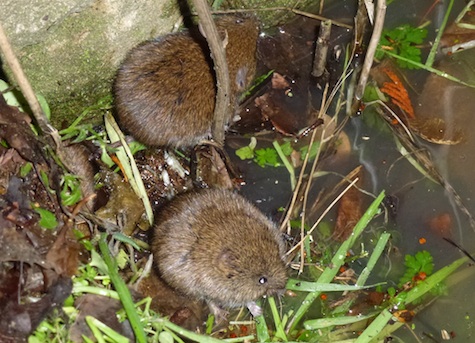- Monday, June 30, 2025
- Stay Connected
 Abraham Lincoln
If given the truth, the people can be depended upon to meet any national crisis...
Abraham Lincoln
If given the truth, the people can be depended upon to meet any national crisis...
 Guildford news...
for Guildford people, brought to you by Guildford reporters - Guildford's own news service
Guildford news...
for Guildford people, brought to you by Guildford reporters - Guildford's own news service
The Dragon Finds Water Voles On Our Doorstep
Published on: 26 Dec, 2013
Updated on: 26 Dec, 2013
A surprising discovery when covering the local floods was a litter of six young water voles, presumably flooded out of their riverbank home.
Their distinctive rounded shape and hairy tails made them quickly distinguishable from mice or rats. (A colloquial name for water voles is water rats. The character ‘Ratty’ in the classic ‘Wind in the Willows’ is in fact a water vole.)
It is obviously good news that they have been spotted locally. Their numbers have been in steep decline across the country, a reduction of 90 per cent since the 1970s, largely, it is thought, because of the spread of the predator American mink, descendants of escapees from fur farms.
The mink are not put off by the water voles’ normal defence mechanism of diving into water and kicking up mud to make the water opaque. They can also hunt them on land and even within their burrows.
However, even without mink the prospects for these cute little youngsters who were probably their parents final brood of the year, in September, are not good. The flood disruption, having forced them into the open, might make them more vulnerable to other predators.
Perhaps more importantly though it might prevent access to their normal herbaceous food, critical to a creature that needs to consume 80 per cent of its own body weight daily.

Then there were three. A total of six young water voles, or pups, were eventually spotted and became quickly used to the presence of our reporter that they were running around his feet. It is likely that they were born in September and were preparing to leave the nest before the floods struck.
Five facts about water voles:
- During the breeding season, the boundaries of female’s ranges are marked with latrines, piles of flattened green droppings where scent marking occurs.
- Each year between April and September, one to five litters consisting of three to seven blind, naked pups can be produced.
- Occasionally, dominant daughters may oust their mother from her territory after bouts of teeth chattering, tail beating and even boxing with the forefeet.
- In winter, a female, her daughters and unrelated males share a communal nest, but they do not hibernate. (Perhaps this was the case with these Guildford water voles?)
- They have a rich chestnut-brown coat, but individuals in Scotland often have black fur.














Jules
December 26, 2013 at 7:29 pm
Fantastic. We need to protect these creatures, by leaving their habitat unspoiled. This means leaving the green belt alone.